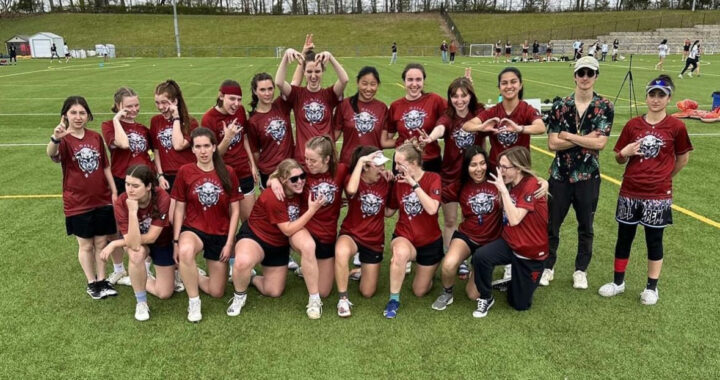Faculty profile: Sociology professor Nora Hui-Jung Kim
6 min read
Dr. Nora Hui-Jung Kim has worked at UMW for 14 years. Ky Huynh/The Weekly Ringer
by KY HUYNH
Staff Writer
Seating for Dr. Nora Hui-Jung Kim’s sociology classes fills rapidly each semester—even her 9:30 a.m., 65-seat intro sociology class held 57 students in the fall of 2022. Not only are Kim’s classes notable for their popularity, but upon walking into her classroom, many students recognize that Kim is one of the few non-white professors at this school.
From cultural events to diverse clubs, the themes of diversity and inclusion are presented in many ways for students at UMW. Even so, statistics from College Simply show that UMW’s racial diversity is low, with 70% of students identifying as white and 30% as people of color.
The professors at UMW, however, are even less diverse. According to College Factual, UMW’s professors are 86.2% white, 9.9% Black and 3.9% Asian.
Kim, a Korean-American professor, has been teaching sociology classes at UMW for the past 14 years, starting in 2009. She was drawn in by the job announcement saying that the sociology department was looking for a scholar who specialized in race in a non-western context.
Despite the promising job description, when she got to UMW, Kim faced a lack of diversity in UMW’s professors—and she is currently the sociology department’s only non-adjunct faculty member of color.
“When I first came here, it was very isolating because there are not that many professors of color,” she said. “There are certain things that I cannot really share with my other professors. … There’s a kind of burden that you carry, that you have to prove yourself—that you’re as good as others.”
Being one of the few Asian professors, Kim also feels that her duties to represent her race extend beyond the classroom on campus. For example, the university often hosts diversity-related events, such as the Asian Cultural Celebration. While well-intentioned, Kim said, these events can put pressure on people of color to participate merely because they belong to the group being celebrated.
“If there are any diversity-related events, then you have to kind of volunteer, even if you don’t want to,” Kim said. “There’s a term called diversity tax. So I’ve definitely felt that diversity tax—that I had to pay extra for those kinds of events.”
Beyond diversity-related events, Kim has also felt pressure to participate in faculty search committees.
“Kind of an unspoken rule is that you have to have one faculty member who is not white on the search committee,” she said. “And there are not that many non-white faculty members. So if there’s 30 going on, they have a really small pool of non-white faculty members to choose from. So I’ve been serving search committees so many times.”
Participating in these committees is incredibly time-consuming and can be frustrating, Kim said.
“It’s a lot of time commitment,” she said. “It was also challenging when I served on search committees for disciplines that have little in common with sociology. It’s rewarding and frustrating at the same time depending on the outcomes.”
In the classroom, Kim teaches classes that are not usually offered or taught by white professors. She offers courses such as Global Inequality and the Sociology of East Asia. And, this semester, she is also teaching a new course on critical refugee studies. She’s found that students of color appreciate her offering courses on diverse subjects that they may not otherwise be able to take.
“One student told me that she never thought this course will be offered at Mary Washington,” she said. “She was glad that this course was offered before she graduated.”
Kim said that some of the best and worst moments in her role as a professor have involved students.
“Teaching-wise, the best moment is when students of color open up,” Kim said.
However, Kim has also experienced several instances of complaints from students.
“Because I have an accent, some students complain that they can’t understand me that well,” she said.
This happened once during an external review of the sociology department, Kim said. Although she was not present when the comment was made, she heard about it afterward.
“It’s heartbreaking, really, because I was also told that other students quickly corrected her, like, ‘Her English is fine, we can understand her no problem,’” she said. “But still, the fact that it’s not what I teach and how I teach, but just because my accent and the way I look, that students are just even not trying.”
According to statistics from Rate My Professors, female professors are rated 28% worse on average than male professors. These evaluations, Kim said, are even worse for female professors of color who have accents.
“It’s frustrating that they don’t see the skills and content of the course that I’m trying to teach,” she said. “They put a barrier and they don’t try to learn or they don’t want to break the barrier … that they put themselves, and then they complain about the barrier as an obstacle of learning.”
Kim is fluent in English and has been speaking the language since she was 25.
“My English is perfectly fine,” she said. “Anybody can understand.”
She feels that her accent is not an issue when it comes to her delivering content in class.
“I would rather put more efforts to improve my pedagogy or do my research than fixing my accent because that’s not something that is efficient use of my time, and also students need to learn how to listen to different accent,” she said. “I don’t feel like I need to change that because of some students’ Eurocentric- and U.S., North American-centric attitude, because everybody has accent. Even native speakers have accent, right? But they don’t think of that as accent.”
On the first day of Kim’s intro sociology class, The Social World, freshman Daniella Asnicar noticed that Kim had an accent. She was concerned about it impacting her learning at first, but after continuing with the class, it didn’t pose an issue.
“I can understand her, she is fluent, and it’s not really a big thing for me,” she said. “I don’t recognize the accent much and don’t see it as a big deterrent in her teaching.”
In the classroom, many students appreciate learning about diverse perspectives from diverse professors. Asnicar only had one white professor during the fall semester of 2022, which provided her with a positive opportunity to learn from different perspectives in her first semester in college.
“I think it’s interesting that she brings up her opinions as a Korean-American professor,” Asnicar said of Kim.
At the beginning of her first semester, freshman Sophia Pedroza was concerned that she may not feel a close relationship with her professors, who were almost all white. She expressed how fortunate she feels to have a Jewish professor to relate to.
“I have a teacher that has Jewish ethnic heritage,” said freshman Sophia Pedroza. “I like her teaching style because I find what she says to be relatable more compared to my other white professors.”
In light of her experiences, Kim has pushed for a more diverse faculty, which she has brought up in faculty meetings several times. Still, the faculty remains mostly white.
“The faculty community has a commitment to that, but when it comes down to decisions, we never actually do it,” she said.
Pedroza also said that students would benefit from more diverse faculty.
“It’s important to have more diverse professors at UMW so more students can culturally connect with them,” she said.
Kim believes more diversity in the curriculum would be beneficial as well.
“We need to change the emphasis on our curriculum from American history to, say, Latin American history,” she said. “Instead of the American society, we teach them more on the global issues and things like that.”
Being at UMW since 2009, Kim has noticed some improvement in UMW’s diversity, but there is more work to be done, she said.
“I wouldn’t say it’s enough, but there are some notable changes. But even if there are some changes, our leadership is still really white,” she said. “That’s oftentimes the case; you see some changes in the faculty members, but still, the leadership is very white, very male. So I think that that’s going to be more difficult and challenging to change those, but once that happens, we’ll see more significant changes.”











